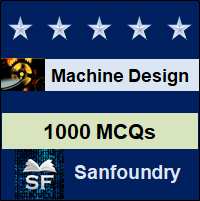This set of Machine Design Multiple Choice Questions & Answers (MCQs) focuses on “Fracture Mechanics, Curved beams & Thermal Stresses”.
1. Stress intensity factor is the critical value of stress at which crack extension occurs.
a) True
b) False
View Answer
Explanation: Stress intensity specifies the stress intensity at the tip of the crack.
2. The critical value at which crack extension occurs is called
a) Stress Intensity Factor
b) Toughness
c) Fracture Toughness
d) None of the mentioned
View Answer
Explanation: Fracture toughness is the critical value of stress intensity at which crack extension occurs.
3. Fracture toughness does not depend upon geometry of the part containing crack
a) True
b) False
View Answer
Explanation: Fracture toughness is directly proportional to a factor Y that depends upon geometry of the part having crack.
4. How many modes are there for crack propagation?
a) 2
b) 3
c) 4
d) 5
View Answer
Explanation: Opening, sliding and tearing are the 3 modes.
5. A curved beam has neutral axis is curved while loaded and straight when unloaded.
a) True
b) False
View Answer
Explanation: Curved beam’s neutral axis is always curved irrespective of the loading.
6. The bending stress in a straight beam varies linearly with the distance from neural axis like that in a curved beam.
a) True
b) False
View Answer
Explanation: Bending stress in a curved beam varies hyperbolically with the distance from neutral axis.
7. If for a curved beam of trapezoidal cross section, radius of neutral axis is 89.1816mm and radius of centroidal axis is 100mm, then find the bending stress at inner fibre whose radius is 50mm. Area of cross section of beam is 7200mm² and the beam is loaded with 100kN of load.
a) 97.3
b) 95.8
c) 100.6
d) None of the mentioned
View Answer
Explanation: e=100-89.816=10.8184mm, h=89.1816-50=39.1816mm, M=100 x 100 N-m
Therefore σ=Mh/AeR or σ=10000 x 39.1816/ [7200 x 10.8184 x 50] or σ=100.6N/mm².
8. A curved beam with eccentricity 0.02D is loaded with 1kN.Centroidal radius=4D and inner and outer radii are 3.5D and 4.5D respectively. Area of cross section is 0.8D². Find the dimension D if allowable stress is 110N/mm².Considering only bending stress.
a) 14.80mm
b) 13.95mm
c) 16.5mm
d) 17.2mm
View Answer
Explanation: σ(b)=Mh/ AeR or σ(b)=1000x4Dx(4D-0.2D-3.5D)/ 0.8D²x0.02Dx3.5D , σ(b)=21428.6/D²
21428.6/D² = 110 or D=13.95mm.
9. A curved beam with eccentricity 0.02D is loaded with 1kN.Centroidal radius=4D and inner and outer radii are 3.5D and 4.5D respectively. Area of cross section is 0.8D². Find the dimension D if allowable stress is 110N/mm² and considering only direct tensile stress.
a) 4.7mm
b) 6.8mm
c) 13.95mm
d) 3.4mm
View Answer
Explanation: Direct Tensile Stress=1000/0.8D² or σ (t) =1250/D²
1250/D²=110 or D=3.4mm.
10. A curved beam with eccentricity 0.02D is loaded with 1kN.Centroidal radius=4D and inner and outer radii are 3.5D and 4.5D respectively. Area of cross section is 0.8D². Find the dimension D if allowable stress is 110N/mm² and considering combined effect of direct stress and bending stress.
a) 15.8mm
b) 14.35mm
c) 17.9mm
d) 18.1mm
View Answer
Explanation: σ(b)=Mh/ AeR or σ(b)=1000x4Dx(4D-0.2D-3.5D)/ 0.8D²x0.02Dx3.5D , σ(b)=21428.6/D²
DirectTensile Stress=1000/0.8D² or σ (t) =1250/D²
Total stress=22678.6/D² N/mm²= 110 or D=14.35mm.
11. If a hollow steel tube is heated from a temperature of 25’C to 250’C then fid the expansion of tube if area of the cross section is 300mm²,length of tube=200mm and coefficient of thermal expansion is 10.8 x 10⁻⁶ per ⁰C.
a) 1.22mm
b) 0.486mm
c) 0.878mm
d) 1.52mm
View Answer
Explanation: Expansion=ἀxlx∆T= 10.8 x 10⁻⁶ x 200 x 225=0.486mm.
12. All type of stresses vanishes after as soon as the applied load is removed.
a) True
b) False
View Answer
Explanation: Residual stresses are independent of the load.
13. Residual stresses are always added in the load stresses and hence are always harmful.
a) True
b) False
View Answer
Explanation: Residual stresses may be beneficial when they are opposite to load stresses and hence are subtracted from load stresses.
Sanfoundry Global Education & Learning Series – Machine Design.
To practice all areas of Machine Design, here is complete set of 1000+ Multiple Choice Questions and Answers.
If you find a mistake in question / option / answer, kindly take a screenshot and email to [email protected]
- Check Metallurgical Engineering Books
- Check Mechanical Engineering Books
- Apply for Mechanical Engineering Internship
- Practice Mechanical Engineering MCQs
- Apply for Metallurgical Engineering Internship

